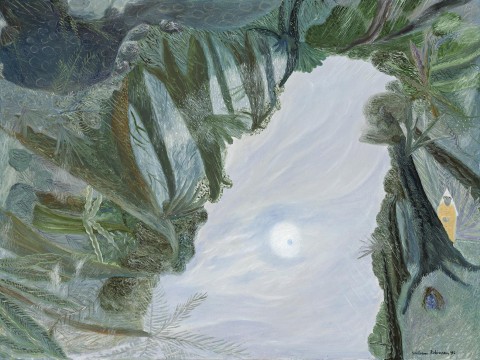RAINFOREST WITH BOWER AND FIGURE, 1990
WILLIAM ROBINSON
oil on canvas
76.5 x 102.0 cm
signed and dated lower right: William Robinson 1990
inscribed with title verso: RAINFOREST WITH BOWER AND FIGURE
Ray Hughes Gallery, Sydney
Private collection
Eva Breuer Art Dealer, Sydney (label attached verso)
Private collection, New South Wales
By 1989 William Robinson already had one Archibald Prize to his name. At the time, Robinson was exhibiting at Sydney’s Ray Hughes Gallery whose stable of artists pursued the annual Archibald, Wynne and Sulman Prizes as a pack. Robinson, Keith Looby and Davida Allen had each won the prize in recent years, so it was with some justification that Ray Hughes’ sense of entitlement led these artists to believe the prize should be awarded to one of them – every year. Robinson, being the most critically and commercially successful artist amongst the Ray Hughes stable, was the leader of the pack. In 1989 the judges whittled the hundreds of Archibald entries down to two paintings; Brian Westwood’s portrait of The Australian newspaper’s art critic Elwyn Lynn and Bill Robinson’s Self Portrait with Goose Feathers. Alas, Robinson would have to wait until 1995 to claim his second Archibald win, the judges awarding the 1989 prize to Westwood’s portrait. ‘Westwood by a goose feather’ read The Sydney Morning Herald’s headline.
All was not lost and the following year Robinson shunned the Archibald and focussed on the Wynne Prize for landscape painting instead. He won with a major landscape and the Art Gallery of New South Wales, Sydney purchased the winning painting for their permanent collection. At the exhibition opening following the announcement of Robinson’s win the Ray Hughes pack arrived at the gallery in a mini bus emblazoned with a banner which read ‘Better Wynne than Lynn’. Today, almost thirty years later, Robinson’s self-portrait wearing his bright yellow raincoat while plucking a goose, is remembered by many as the actual winner of the 1989 Archibald Prize.
In Rain Forest with Bower and Figure, 1990, painted in the months following the cut and thrust of the Archibald prize, we see the artist still sporting his yellow rain coat while quietly observing a bower of the so named bird. The Satin Bowerbird collects bright blue detritus and arranges these items around a delicately constructed grass arch, which forms the heart of the bower. The male bird is totally obsessed with creating the bower and great care goes into its presentation. Then after many hours, days and weeks of posing and posturing in attempts to lure a mate, it happens. The female enters and it is over in a flash, the male then abandoning his bower and allowing nature to reclaim it.
In this painting we see the artist surrounded by the landscape, perhaps a little battle weary. Cloistered in the security of his familiar misty forest and a world away from the glare of the Archibald circus, the artist’s consideration of the bower causes him to reflect on the lure of the prize. The enormous effort that the bird puts into creating the bower, which in the end delivers just a moment’s rich reward, seems to parallel Robinson’s own experience of seeking bright and shiny things – such as art prizes.
HENRY MULHOLLAND
